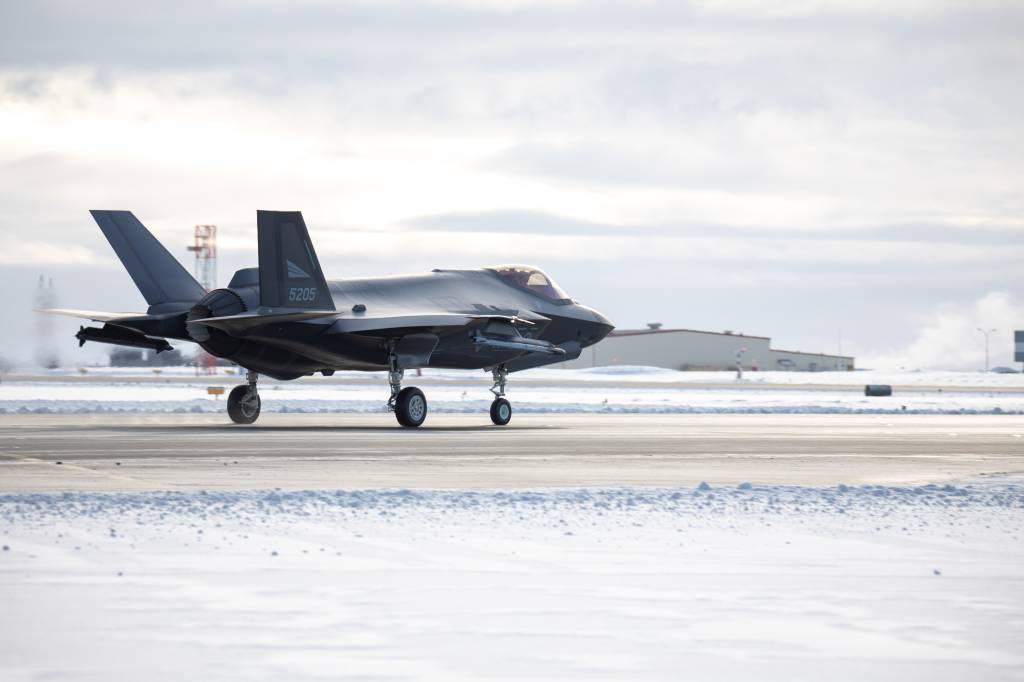
Iceland Air Policing
Norwegian fighter jets regularly patrol Icelandic airspace on behalf of NATO, most recently in the winter of 2024.
Iceland does not have an air force of its own. In order to meet Iceland's need for peacetime preparedness and airspace surveillance, NATO provides a periodic presence for air surveillance and interception capabilities. The mission is called Iceland Air Policing (IAP) and it is conducted by NATO member countries for three to four weeks at a time. IAP maintains the integrity of NATO airspace.
What did Norway do?
In January and Februar 2024, Norway deployed four F-35s to the Keflavík Air Base in Iceland, of which two were on standby 24–7. The Norwegian combat aircraft were ready to be scrambled at any given hour from Keflavík. If an unidentified aircraft came close to Icelandic airspace, for example, the squadron received a message to launch the F-35s immediately to identify the unknown aircraft.
The Royal Norwegian Air Force is highly capable for this readiness mission, called Quick Reaction Alert (QRA). Norwegian F-35s carry out a similar mission for NATO from Evenes Air Base in Norway, where they are ready to be scrambled 24–7.

From Iceland Air Policing 2021. Photo by Ole Andreas Vekve, Norwegian Armed Forces 
From Iceland Air Policing 2021. Photo by Ole Andreas Vekve, Norwegian Armed Forces 
From Iceland Air Policing 2021. Photo by Ole Andreas Vekve, Norwegian Armed Forces 
From Iceland Air Policing 2021. Photo by Ole Andreas Vekve, Norwegian Armed Forces 
Norwegian force protection during Iceland Air Policing 2021. Photo by Ole Andreas Vekve, Norwegian Armed Forces
The 2024-deployment to Keflavik was Norway's fourth time around with our F-35s. We have carried out IAP numerous times before with our previous fighters, the F-16. The Norwegian mission consisted of approximately 100 people, from pilots, technicians, logistics personnel to other support functions. This also included Norwegian control and reporting personnel, who monitored and produced a recognised air picture (RAP) of Icelandic airspace.
The Air Policing mission itself lasted for three weeks, but the contingent worked together for weeks both before and after the mission for tasks related to preparation, transportation and redeployment.
Iceland Air Policing is important for NATO as a whole, but also for Norway. Throughout the mission, the Norwegian Armed Forces were able to set the weapon system to various tests and enhance our capability to operate our F-35s, with its necessary support functions, outside of Norwegian territory.
More about the mission
-
Iceland is one of the founding countries of NATO, and the country signed the North Atlantic Treaty in 1949. Through a 1951 agreement, the United States agreed to provide for the military defence of Iceland – through the Iceland Defense Force. In 2006, the United States terminated the Iceland Defense Force and withdrew its forces from the country.
The United States guaranteed it would still defend Iceland in the event of a crisis or war. However, continuous monitoring and air policing of Iceland’s airspace in peacetime was not part of the US guarantee. In 2007, NATO agreed to provide Iceland with protection of its airspace. The first deployment of aircraft took place in May 2008. The IAP is not a permanent mission, instead there are three deployments a year, each lasting 3–4 weeks. The mission rotates between NATO countries, and Norway has had eight deployments so far – most recently in January and February 2024.
-
The F-35 is a highly advanced and sophisticated weapons platform, and has already been a part of the Royal Norwegian Air Force for years. The first F-35s landed in Norway in 2017. The system reached its initial operating capability in 2019, and the Norwegian F-35 fleet will be fully operational in 2025.
The Royal Norwegian Air Force is on track with operational testing and evaluation, and education of F-35 personnel in Norway. As of February 2023, Norway has received a total of 40 F-35 fighter jets. Most of the aircraft are stationed at Ørland Air Base and Evenes Air Base, while seven are based at Luke Air Force Base in Arizona, USA, where they are used for training and educating new F-35 personnel.
Several other NATO nations have also received their F-35. This is vital for the cooperation within the Alliance, and for developing Norwegian operational personnel and maintaining the F-35s. The platform is also an important contribution to Norwegian defence capability and to NATO’s collective defence.
-
Also known as QRA, is a 24-hour mission that Norway performs on behalf of NATO.
QRA simply means that Norway continuously monitors Norwegian airspace and all traffic near our airspace. Should an unknown aircraft appear close to Norwegian airspace, two Norwegian F-35s from Evenes Air Base will be airborne within 15 minutes.
When airborne, Norwegian CRC personnel (Control and Reporting Centre) guide the F-35s towards the unknown aircraft to identify and document them. This job is called air policing.
Norwegian fighters have conducted several air policing missions abroad, most recently in Lithuania in 2015, and in Iceland in 2016, 2020, 2021 and 2023. Until 2020, the missions were solved with F-16s, and from 2020 on with F-35s.
In 2022, Norway retired its fleet of F-16s, and the new fleet of F-35s took over.



